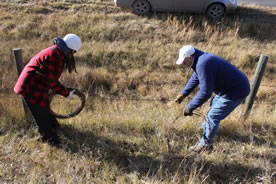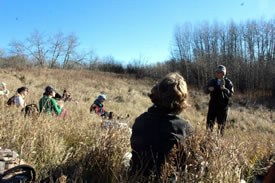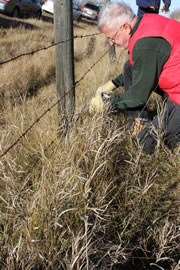Advocates for health!

Conservation Volunteers removing barbed wire to allow better passage for wildlife (Photo by Natalie Trofimencoff)
On November 6, an eager group of Conservation Volunteers (CVs) was greeted by mild weather and sunshine at the Gray Property near Cooking Lake, Alberta, recently acquired by the Nature Conservancy of Canada (NCC).
The goal was to remove the top and bottom of barbed wire fencing in open areas and completely remove the fencing in treed areas, to allow better movement for wildlife. Working in teams, each volunteer had a role to execute the work efficiently. One person would remove and collect the staples in the fencing while another would cut the wire in 10-metre lengths. We worked together to wind up the barbed wire fence in wheels, to be recycled at the end of the day.
When it seems that the world is full of chaos, it can be easy to feel like one’s efforts can go unseen and unfelt. However minimal, volunteering to make our living space more beautiful can give you a sense of accomplishment.
The group of volunteers assembled that day came from various backgrounds such as science, finance, oil and gas, students and retirees. We were of varying ages and backgrounds, yet we all had one thing in common: to leave a better space. The desire to help the environment was discussed by everyone I spoke to. Our shared goal allowed us to take direction and finish the work in a highly organized, efficient manner.
The work was done quickly, ahead of schedule and happily with an ease felt by all.

Glen Lawrence speaks to the volunteers about Beaver Hills as a living landscape (Photo by Natalie Trofimencoff)
A lesson about the Beaver Hills
During lunch, we were delighted to receive a presentation by Glen Lawrence, the chair of the Beaver Hills Initiative since 2002 and an enthusiast for protecting this area. He was quick to inform us that Beaver Hills has been on maps since the first settlers! We learned about the history of Beaver Hills, how the aboriginal and fur trade history affected this region and how important it is for us to conserve it for future generations.
This area is special due to the historic nature of the glaciers in this region. The landscape is part of the Aspen Parkland Belt, used as a corridor for migrating herds as well as shelter for wintering wildlife.
Beaver Hills is a unique landscape in Cooking Lake Moraine. The landform was created by a unique glacial occurrence that left a knob and kettle terrain. The area is surrounded by other protected areas such as Elk Island National Park, Miquelon Lake Provincial Park, Ministik Bird Sanctuary and Cooking Lake-Blackfoot Provincial Recreation Area.
The rich history of this area, as well as its unique landscape, needed to be recognized and conserved. In order to better protect this unique landscape, Glen informed us of Beaver Hills recently attempting to become a recognized biosphere reserve. Biosphere status would allow access to funding, tourism and in turn protection of this unique living landscape.
Want to know more?
Biospheres are made up of three pillars: the economy, the environment and culture and society.
For more information, visit the Canadian Biosphere Reserve Association’s FAQ.
You can learn more about Beaver Hills in The Beaver Hills Country: A history of Land and Life, by Graham A. MacDonald.

Werner Groeschel removing the bottom barbed wire fence to allow better passage for wildlife (Photo by Natalie Trofimencoff)
Our volunteers answer: “Why do you like to volunteer?”
Werner Groeschel: “I like to volunteer to help nature and to meet like-minded people. It’s like going to church. They [NCC] do a great job educating.”
Denise Harris: “I’m an advocate for health.”
Christine L. Reimer: “It was something nice to do; why not?”
We have a responsibility to create better living landscapes for our health and well-being. Volunteering for a non-profit organization such as NCC is appreciated by the hard-working employees. It was a priveledge to work with a passionate group of people who strive to protect pieces of beauty and attempt to allow nature to do its thing.


